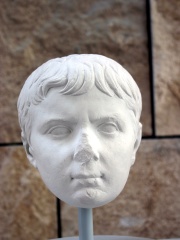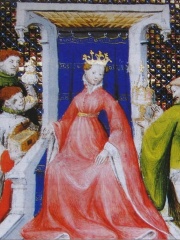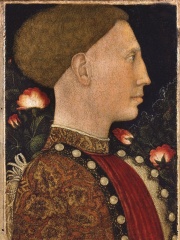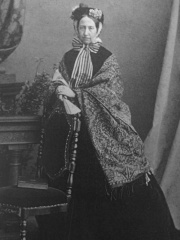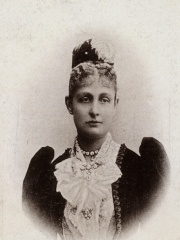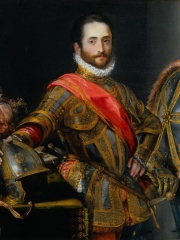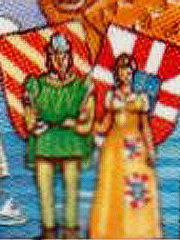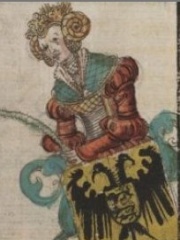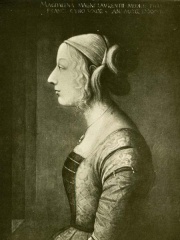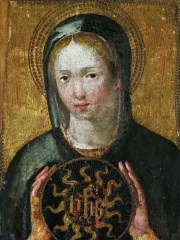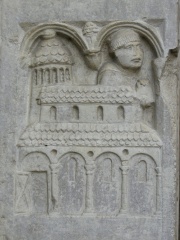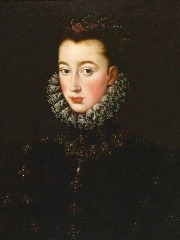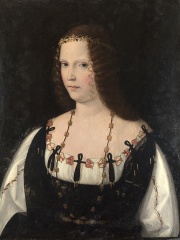
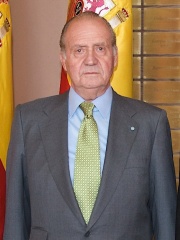
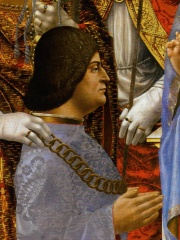
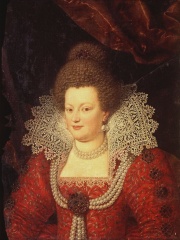
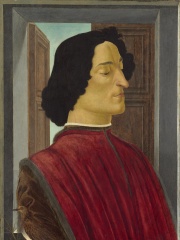
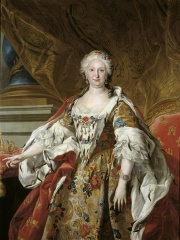
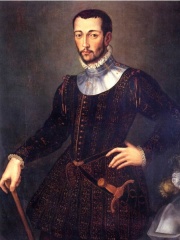
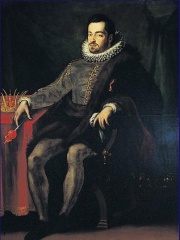
The Most Famous
NOBLEMEN from Italy
Top 10
The following people are considered by Pantheon to be the top 10 most legendary Italian Noblemen of all time. This list of famous Italian Noblemen is sorted by HPI (Historical Popularity Index), a metric that aggregates information on a biography’s online popularity. Visit the rankings page to view the entire list of Italian Noblemen.

1. Lucrezia Borgia (1480 - 1519)
With an HPI of 78.23, Lucrezia Borgia is the most famous Italian Nobleman. Her biography has been translated into 66 different languages on wikipedia.
Lucrezia Borgia (Italian pronunciation: [luˈkrɛttsja ˈbɔrdʒa]; Valencian: Lucrècia Borja [luˈkrɛsia ˈbɔɾdʒa]; 18 April 1480 – 24 June 1519) was an Italian noblewoman of the House of Borgia who was the illegitimate daughter of Pope Alexander VI and Vannozza dei Cattanei. She reigned as the governor of Spoleto, a position usually held by cardinals, in her own right. Her family arranged several marriages for her that advanced their own political position including Giovanni Sforza, Lord of Pesaro and Gradara, Count of Cotignola; Alfonso of Aragon, Duke of Bisceglie and Prince of Salerno; and Alfonso I d'Este, Duke of Ferrara. Alfonso of Aragon was an illegitimate son of the King of Naples and tradition has it that Lucrezia's brother Cesare Borgia may have had him murdered after his political value waned. Rumors about her and her family cast Lucrezia as a femme fatale, a role in which she has been portrayed in many artworks, novels and films.

2. Juan Carlos I of Spain (b. 1938)
With an HPI of 76.65, Juan Carlos I of Spain is the 2nd most famous Italian Nobleman. His biography has been translated into 105 different languages.
Juan Carlos I (Spanish: [xwaŋˈkaɾlos]; Juan Carlos Alfonso Víctor María de Borbón y Borbón-Dos Sicilias, born 5 January 1938) is a member of the Spanish royal family who reigned as King of Spain from 22 November 1975 until his abdication on 19 June 2014. In Spain, since his abdication, Juan Carlos has usually been referred to as the rey emérito ('king emeritus') by the press.Juan Carlos is the son of Infante Juan, Count of Barcelona, and grandson of Alfonso XIII, the last king of Spain before the abolition of the monarchy in 1931 and the subsequent declaration of the Second Spanish Republic. Juan Carlos was born in Rome, Italy, during his family's exile. Francisco Franco took over the government of Spain after his victory in the Spanish Civil War in 1939, yet in 1947 Spain's status as a monarchy was affirmed and a law was passed allowing Franco to choose his successor. Juan Carlos's father assumed his claims to the throne after King Alfonso XIII died in February 1941. However, Franco saw Juan Carlos's father to be too liberal and in 1969 declared Juan Carlos his successor as head of state.Juan Carlos spent his early years in Italy and came to Spain in 1947 to continue his studies. After completing his secondary education in 1955, he began his military training and entered the General Military Academy at Zaragoza. Later, he attended the Naval Military School and the General Academy of the Air, and finished his tertiary education at the University of Madrid. In 1962, Juan Carlos married Princess Sophia of Greece and Denmark in Athens. The couple have three children: Elena, Cristina, and Felipe. Due to Franco's declining health, Juan Carlos first began periodically acting as Spain's head of state in the summer of 1974. In November the following year, Franco died and Juan Carlos became king. Juan Carlos was expected to continue Franco's legacy, but instead introduced reforms to dismantle the Francoist regime and to begin the Spanish transition to democracy soon after his accession. This led to the approval of the Spanish Constitution of 1978 in a referendum which re-established a constitutional monarchy. In 1981, Juan Carlos played a major role in preventing a coup that attempted to revert to Francoist government in the king's name. In 2008, he was considered the most popular leader across all Ibero-America. Hailed for his role in Spain's transition to democracy, the King and the monarchy's reputation began to suffer after controversies surrounding his family arose, exacerbated by the public controversy centering on an elephant-hunting trip he undertook during a time of financial crisis in Spain. In June 2014, Juan Carlos, citing personal reasons, abdicated in favour of his son, who acceded to the throne as Felipe VI. Since August 2020, Juan Carlos has lived in self-imposed exile from Spain over allegedly improper ties to business deals in Saudi Arabia. The New York Times estimated in 2014 that Juan Carlos's fortune was around 1.8 billion euros (2.3 billion U.S. dollars).

3. Ludovico Sforza (1452 - 1508)
With an HPI of 74.20, Ludovico Sforza is the 3rd most famous Italian Nobleman. His biography has been translated into 50 different languages.
Ludovico Maria Sforza (Italian: [ludoˈviːko maˈriːa ˈsfɔrtsa]; 27 July 1452 – 27 May 1508), also known as Ludovico il Moro (Italian: [il ˈmɔːro]; "the Moor"), and called the "arbiter of Italy" by historian Francesco Guicciardini, was an Italian nobleman who ruled as the Duke of Milan from 1494 to 1499. Although he was the fourth son and excluded from his family's succession, Ludovico was ambitious and managed to obtain dominion over Milan. He first assumed the regency from his sister-in-law Bona, then took over from his deceased nephew Gian Galeazzo, whom some say he poisoned. Considered enlightened, generous, and peaceful, he became a patron of artists and writers. His court in Milan became one of the most important in Europe during the Italian Renaissance.Somewhat contrarily, Ludovico was also considered fearful and of a fickle nature. To face the threats of King Alfonso II of Naples, Ludovico called the French to Italy; when threatened by the French, he could not face the danger, and was saved only thanks to the intervention of his wife, Beatrice. When she died, he went into a depression and the state of his court fell from jubilance to despair. He finally succumbed to King of France Louis XII, who imprisoned him in France where he died.

4. Marie de' Medici (1575 - 1642)
With an HPI of 73.07, Marie de' Medici is the 4th most famous Italian Nobleman. Her biography has been translated into 63 different languages.
Marie de' Medici (French: Marie de Médicis; Italian: Maria de' Medici; 26 April 1575 – 3 July 1642) was Queen of France and Navarre as the second wife of King Henry IV. Marie served as regent of France between 1610 and 1617 during the minority of her son Louis XIII. Her mandate as regent legally expired in 1614, when her son reached the age of majority, but she refused to resign and continued as regent until she was removed by a coup in 1617. Marie was member of the powerful House of Medici in the branch of the grand dukes of Tuscany. The wealth of her family caused Marie to be chosen by Henry IV to become his second wife after his divorce from his previous wife, Margaret of Valois. The assassination of her husband in 1610, which occurred the day after her coronation, caused her to act as regent for her son, Louis XIII, until 1614, when he officially attained his legal majority, but as the head of the Conseil du Roi, she retained the power.Noted for her ceaseless political intrigues at the French court, her extensive artistic patronage and her favourites (the most famous being Concino Concini and Leonora Dori), she ended up being banished from the country by her son and dying in the city of Cologne, in the Holy Roman Empire.

5. Archduke Charles, Duke of Teschen (1771 - 1847)
With an HPI of 69.17, Archduke Charles, Duke of Teschen is the 5th most famous Italian Nobleman. His biography has been translated into 44 different languages.
Archduke Charles Louis John Joseph Laurentius of Austria, Duke of Teschen (German: Erzherzog Karl Ludwig Johann Josef Lorenz von Österreich, Herzog von Teschen; 5 September 1771 – 30 April 1847) was an Austrian field-marshal, the third son of Emperor Leopold II and his wife, Maria Luisa of Spain. He was also the younger brother of Francis II, Holy Roman Emperor. He was epileptic, but achieved respect both as a commander and as a reformer of the Austrian army. He was considered one of Napoleon's more formidable opponents and one of the greatest generals of the French Revolutionary and Napoleonic Wars. He began his career fighting the revolutionary armies of France. Early in the wars of the First Coalition, he saw victory at Neerwinden in 1793, before being defeated at Wattignies in 1793 and Fleurus in 1794. In 1796, as chief of all Austrian forces on the Rhine, Charles defeated Jean-Baptiste Jourdan at Amberg, Würzburg and Limburg, and then won victories at Wetzlar, Emmendingen and Schliengen that forced Jean Victor Marie Moreau to withdraw across the Rhine. He also defeated opponents at Zürich, Ostrach, Stockach, and Mannheim in 1799. He reformed Austria's armies to adopt the nation-at-arms principle. In 1809, he entered the War of the Fifth Coalition and inflicted Napoleon's first major setback at Aspern-Essling, before suffering a defeat at the bloody Battle of Wagram. After Wagram, Charles saw no more significant action in the Napoleonic Wars. As a military strategist, Charles was able to successfully execute complex and risky manoeuvres of troops. However, his contemporary Carl von Clausewitz criticised his rigidity and adherence to "geographic" strategy. Many Austrians nevertheless remember Charles as a hero of the French Revolutionary and Napoleonic Wars.

6. Giuliano de' Medici (1453 - 1478)
With an HPI of 69.09, Giuliano de' Medici is the 6th most famous Italian Nobleman. His biography has been translated into 37 different languages.
Giuliano de' Medici (28 October 1453 – 26 April 1478) was the second son of Piero de' Medici (the Gouty) and Lucrezia Tornabuoni. As co-ruler of Florence, with his brother Lorenzo the Magnificent, he complemented his brother's image as the "patron of the arts" with his own image as the handsome, sporting "golden boy". He was killed in a plot known as the Pazzi conspiracy in 1478.

7. Elisabeth Farnese (1692 - 1766)
With an HPI of 68.23, Elisabeth Farnese is the 7th most famous Italian Nobleman. Her biography has been translated into 40 different languages.
Elisabeth Farnese (Italian: Elisabetta Farnese, Spanish: Isabel de Farnesio; 25 October 1692 – 11 July 1766) was Queen of Spain by marriage to King Philip V. She was the de facto ruler of Spain from 1714 until 1746 since she managed the affairs of state with the approval of her spouse, and is particularly known for her great influence over Spain's foreign policy. From 1759 until 1760, she governed as regent.

8. Francesco I de' Medici, Grand Duke of Tuscany (1541 - 1587)
With an HPI of 67.24, Francesco I de' Medici, Grand Duke of Tuscany is the 8th most famous Italian Nobleman. His biography has been translated into 36 different languages.
Francesco I (25 March 1541 – 19 October 1587) was the second Grand Duke of Tuscany, ruling from 1574 until his death in 1587. He was a member of the House of Medici.

9. Ferdinando I de' Medici, Grand Duke of Tuscany (1549 - 1609)
With an HPI of 66.68, Ferdinando I de' Medici, Grand Duke of Tuscany is the 9th most famous Italian Nobleman. His biography has been translated into 39 different languages.
Ferdinando I de' Medici, Grand Duke of Tuscany (30 July 1549 – 3 February 1609) was Grand Duke of Tuscany from 1587 to 1609, having succeeded his older brother Francesco I.
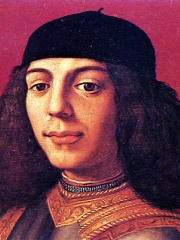
10. Piero the Unfortunate (1472 - 1503)
With an HPI of 66.50, Piero the Unfortunate is the 10th most famous Italian Nobleman. His biography has been translated into 35 different languages.
Piero di Lorenzo de' Medici (15 February 1472 – 28 December 1503),: 7 called Piero the Fatuous or Piero the Unfortunate, was the lord of Florence from 1492 until his exile in 1494.
People
Pantheon has 107 people classified as Italian noblemen born between 20 BC and 1938. Of these 107, 1 (0.93%) of them are still alive today. The most famous living Italian noblemen include Juan Carlos I of Spain. The most famous deceased Italian noblemen include Lucrezia Borgia, Ludovico Sforza, and Marie de' Medici. As of April 2024, 20 new Italian noblemen have been added to Pantheon including Leonello d'Este, Maria Beatrix of Austria-Este, and Princess Maria Immacolata of Bourbon-Two Sicilies.
Living Italian Noblemen
Go to all RankingsDeceased Italian Noblemen
Go to all RankingsLucrezia Borgia
1480 - 1519
HPI: 78.23
Ludovico Sforza
1452 - 1508
HPI: 74.20
Marie de' Medici
1575 - 1642
HPI: 73.07
Archduke Charles, Duke of Teschen
1771 - 1847
HPI: 69.17
Giuliano de' Medici
1453 - 1478
HPI: 69.09
Elisabeth Farnese
1692 - 1766
HPI: 68.23
Francesco I de' Medici, Grand Duke of Tuscany
1541 - 1587
HPI: 67.24
Ferdinando I de' Medici, Grand Duke of Tuscany
1549 - 1609
HPI: 66.68
Piero the Unfortunate
1472 - 1503
HPI: 66.50
Gaius Caesar
20 BC - 4
HPI: 66.42
Joanna I of Naples
1326 - 1382
HPI: 66.22
Giovanni Borgia, 2nd Duke of Gandia
1474 - 1497
HPI: 65.46
Newly Added Italian Noblemen (2024)
Go to all RankingsLeonello d'Este
1407 - 1450
HPI: 56.25
Maria Beatrix of Austria-Este
1824 - 1906
HPI: 55.97
Princess Maria Immacolata of Bourbon-Two Sicilies
1844 - 1899
HPI: 55.96
Francesco Maria II della Rovere
1549 - 1631
HPI: 54.74
Rainier II, Lord of Monaco
1325 - 1407
HPI: 54.66
Margaret of Sicily
1237 - 1270
HPI: 53.97
Maddalena de' Medici
1473 - 1519
HPI: 53.86
Guy, Margrave of Tuscany
900 - 930
HPI: 53.05
Flavia Domitilla
HPI: 52.49
Anselm, Duke of Friuli
720 - 803
HPI: 52.48
Beatrice of Sicily, Latin Empress
1252 - 1275
HPI: 52.46
Lucrezia d'Este
1535 - 1598
HPI: 52.05
Overlapping Lives
Which Noblemen were alive at the same time? This visualization shows the lifespans of the 25 most globally memorable Noblemen since 1700.

